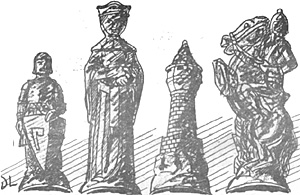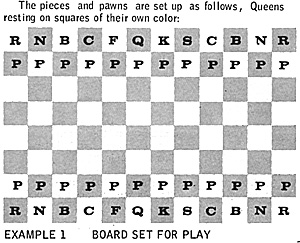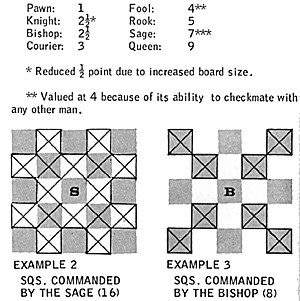 We all agree that chess is a wargame, and if you think about it you will realize that it isn't a boardgame but miniatures. Be that as it may, it does allow me to treat the subject here, and that is why the fact was brought up. Most wargamers enjoy at least a little variety in their gaming, and chess--in its variants and varieties--can provide no little fresh and stimulating play, especially when there is only limited time in which to contend. The particular variant which will be detailed here is the modern version of the Courier Game.
We all agree that chess is a wargame, and if you think about it you will realize that it isn't a boardgame but miniatures. Be that as it may, it does allow me to treat the subject here, and that is why the fact was brought up. Most wargamers enjoy at least a little variety in their gaming, and chess--in its variants and varieties--can provide no little fresh and stimulating play, especially when there is only limited time in which to contend. The particular variant which will be detailed here is the modern version of the Courier Game.
It is probable that the original Courier variant was developed many hundred years ago, with the pieces moving on a much more limited range than the version given below. The additional pieces, Sage and Fool, moved as the King and one square diagonally respectively, while the Bishop hopped two squares diagonally being able to vault any man intervening. This early version, then, had only a few more pieces of limited power and offered little to players of the standard chess game. However, by raising the mobility of the pieces, a very interesting new game was created, with a larger field of battle to maneuver upon.
The board is 8 x 12, merely a regular chess board with four files added. To make one simply buy two inexpensive cardboard boards at the nearest dime store, trim the appropriate edges, and cut away the excess. As in chess, the square in the lower right corner must be white.
 The pieces and pawns are set up as follows, Queens resting on squares of their own color:
The pieces and pawns are set up as follows, Queens resting on squares of their own color:
The men are easily obtained from two chess sets, one being of smaller size than the other. From the smaller set take the four additional Pawns, the King (for the Fool), the Queen (for the Sage) and the two Bishops (for Bishops--the larger Bishops being used as the Couriers).
Most of the men move exactly as in chess, the Courier corresponding to the Bishop. The added pieces, as well as the Bishop of Courier chess, move as follows:
- Sage--combination of King and Knight (Example 2)
Fool--moves as a King
Bishop--one or two squares diagonally, with the ability to vault (Example 3)
 Thus, it can be seen that the four new pieces are quite powerful (although of somewhat limited range) and cause a considerable change in tactical thinking. As an estimate, I offer the following valuations for the pieces and pawns:
Thus, it can be seen that the four new pieces are quite powerful (although of somewhat limited range) and cause a considerable change in tactical thinking. As an estimate, I offer the following valuations for the pieces and pawns:
-
Pawn: 1
Knight: 2.5*
Bishop: 2.5
Courier: 3
Fool: 4**
Rook: 5
Sage: 7***
Queen: 9
Reduced 1/2 point due to increased board size.
** Valued at 4 because of its ability to checkmate with any other man.
*** The mobility of the Knight coupled with the power of the King causes a valuation of slightly more than the sum of the two men.
Although the larger board gives the far-ranging Queen, Rook, and Courier more possible squares to command, they control relatively a smaller percentage of the board when compared to chess, so their valuation remains the same as in the latter game. Note that each side now has three pieces which can checkmate with only one other man--instead of only one (the Queen) as in chess--being the Fool, Sage, and Queen.
Pawns queen exactly as they do in chess, so their relative value of 1 should be reasonably accurate in the Courier Game. However, in the few dozen games I have played a Pawn has never been queened, although the threat of this eventuality has had considerable effect on play.
Because of the extended width of the board, play does not revolve so strictly around the center as it does in chess. There are very definite flanks--the Rook, Knight, and Bishop files. Operations often take place on these wings, and the flanks must be carefully guarded. Because of the necessity of watching three fronts, as well as the greater number of men, the opening requires 10-15 moves in order to properly develop. A not untypical (but far from flawless) opening plays as follows:
- WHITE : BLACK
1. P-KB3 : P-F4
2. C-KB2 : P-Q4
3. N-KR3 : P-K4
4. P-Q4 : P-S3
5. P-F4 : N-KB3
6. N-QB3 : C-S2
7. P-KC4 : B-F3
8. B-S3 : S-Q2
9. S-KC2 : B-R3
10. O-O : O-O
11. C-F2 : C-Q3
12. B-F3 : P-QC3
Hereafter the middle game begins, and the possible moves are far too numerous to contemplate.
Anyone who can push pawns at chess can play the Courier variant, and the new horizons offered by the game will be most refreshing to all but the most dedicated chess fanatic. Next time you have only an hour or two for gaming, set up the board and give it a try. It is a good bet you won't be sorry.
Back to Table of Contents -- Panzerfaust #56
To Panzerfaust/Campaign List of Issues
To MagWeb Master Magazine List
© Copyright 1972 by Donald S. Lowry.
This article appears in MagWeb (Magazine Web) on the Internet World Wide Web.
Other military history articles and gaming articles are available at http://www.magweb.com